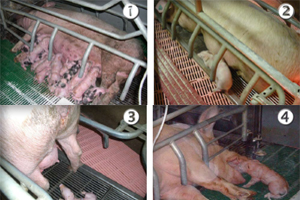New research on farrowing at French Pig vets congress

Lallemand presented new research on farrowing at French Pig vets congress. During the last Annual Congress of the French Swine Veterinarians Association (AFMVP- French branch of IPVS), that took place in Paris last month, several new studies conducted in partnership with Toulouse Vets School (ENVT) were presented by Dr. Guy-Pierre Martineau from ENVT.
They all focused on the critical time of farrowing and aimed at getting a better understanding of some of the factors involved in farrowing quality and subsequent piglet performance. One study allowed designing a new evaluation tool to assess the maternal behavior in swine at farrowing, showing that this parameter is also correlated to piglet performance in maternity. The new studies were very well received by an audience of around 80 vets specialised in swine medicine, as they brought practical conclusions: additional evidences of the impact of stress factors on piglet performance, and practical guidelines about adoption in farms.
A new tool to evaluate sow behavior at farrowing
The first study presented in Paris concerned the effect of sow behavior in maternity and its influence on the quality of the farrowing process: Sow behavior evaluation at farrowing and first conclusions.
First of all this study proposed a practical evaluation scale to characterise sow behavior at farrowing and the difficulty of farrowing. The study confirmed the importance of sows “nervous” behavior in maternity (around 40%): a negative behavior that can have major consequences on piglets such as bitten and crushed piglets.
A correlation was also found between maternal behavior and piglets performances in maternity: piglets from calm mothers were significantly more vigorous at birth, while piglets mortality was higher for aggressive sows, with negative consequences on piglets weight at birth. This study suggests that sow’s behavior during farrowing is an interesting factor to take into account in order to evaluate the quality of farrowing and to be able to predict piglet performances in maternity. This new tool will be of great value to objectively assess the impact of live yeast Levucell SB on sow’s behavior, an effect which until now has been widely reported but not easily quantified.
Sex effect on piglet performance
The second study, titled: Males/Females all equal? – Sex influence on teats position and performances in maternity, aimed at looking at the sex effect in maternity. This original study monitored the performances and characteristics in maternity of over 800 piglets in a commercial farm. It was shown that both females and males showed similar characteristics at birth in terms of morphology, vitality and maturity. However, males were heavier at birth and remained so until the first week of life. But, at weaning, the sex effect on weight had disappeared.
Additionally, the study indicated that males tended to suckle front teats from birth to weaning. The weight advantage of the males was only observed for piglets from those front teats. For the males on posterior teats (less milk), the females caught up with the males and became even heavier at weaning.
Both sex received the same interventions in maternity, except for male castration on day five. The authors suggested that this stressful event did slow down the growth of males, while males performed better in the first days of life.
Drawing adoption guidelines for optimal performance
The follow-up of this study was presented as a short oral communication by Dr. Guy-Pierre Martineau, titled: Impact of the nipple position on the performance of piglets maternity: interaction with adoption. This study focused on the fate of adopted piglets, a growing practice in today’s hyperprolificacy context. In the studied farm, adopted piglets were less vigorous at birth than non adopted piglets. They essentially came from significantly bigger litters and older parity sows. In terms of performances, adoption had no impact on mortality, however, piglet weight delay was maintained up to weaning. Finally, unlike for the ‘non-adopted’ piglets, there was a correlation between teat position and piglet vitality and weight at birth for the adopted piglets: the lighter and less vigorous piglets tended to suckle from posterior teats, where there is less milk.
One of the practical advices to draw from this study is that adoption practices should consider vitality and weight characteristics: piglets with homogenous vitality and weight should be adopted together as much as possible.
Source: Lallemand











